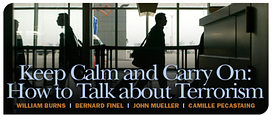Camille Pecastaing offers a number of useful insights in response to my essay and Bernard Finel’s and John Mueller’s comments. He begins by pointing out that what I call fear in my essay is really anxiety. This is a good point, because fear is more visceral but anxiety endures well past the traumatic events. Anxiety and negative affect are closer to the reactions I am most concerned about. He also argues correctly that anger or outrage were common reactions to the events of September 11th. I do object to his use of the word hysteria however; this is a loaded term. I do not think hysteria accurately describes how most Americans responded to the attacks on the Twin Towers or the Pentagon.
Dr. Pecastaing speaks of a kind of conspiracy — dominant winds blowing in the same direction — in which the administration, media, and public together became numb to reason. I believe the public in a state of chronic anxiety ignored the probabilities of future attacks, failed to consider the opportunity costs of going to war, and, being distracted, failed to see other risks that eventually led to the financial crisis. Very puzzling was the media’s lack of serious investigative journalism leading up to the war.
Interesting is the comment pertaining to the Department of Homeland Security paradigm of zero-risk. This fantasy objective, as Dr. Pecastaing calls it, has big implications. If true, it suggests that that no amount of funding is too large in the effort to protect our country. As I indicate above, such focus has large opportunity costs. What do we give up in pursuit of this standard? The public appears to implicitly expect this level of protection as well. There is a sad irony here. The longer we go without being attacked the more pressure there may be for our nation’s leaders to adhere to unreasonable standards to avoid having another attack on their watch.
I agree that there are two primary dynamics that we need to pay attention to if we are to properly understand public reaction. First, there is the reaction of fear, anger, and anxiety that follows a terrorist attack. These emotions tend to amplify the risk causing us to overestimate the event’s impact. In this state of mind we may favor drastic rather than measured response. Second, we also observe that the public tends to self-correct in the months following an attack. This process helps put the breaks on overreaction. Whichever set of feedback loops is stronger will determine the net reaction at any given point after the attack. We would do well to study this balancing mechanism so that we can design risk communication strategies that help mitigate overreaction. Well designed risk communication may have enormous policy relevance in this regard.

